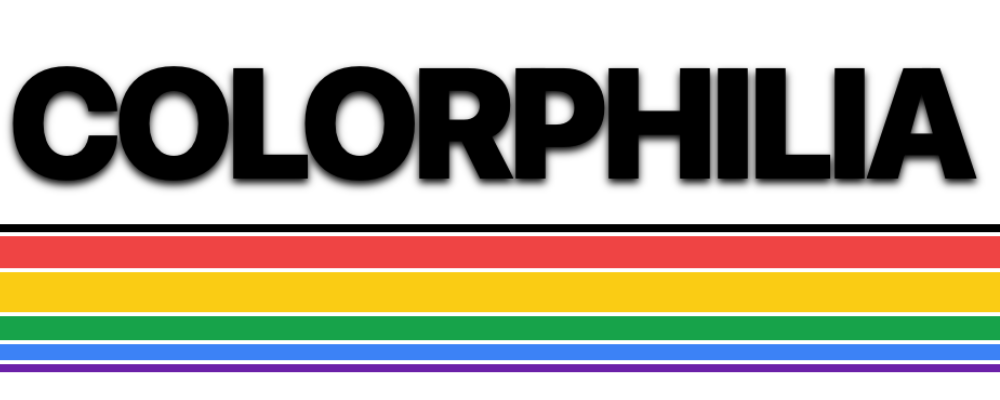Pastel / Macaroni
The relationship between pastels and macarons.

In this newsletter, we're going to explore the colorful relationship between words which seem to have nothing in common, besides the fact that they happen to be very much related.
Two notes:
- On September 25, I'll be giving a webinar lecture (in English) about the relationship between color and curiosity for the Israeli "Curiosity Club" titled "Curiouser and curiouser: falling down the rabbit-hole of color, and why the truth is usually better than the myth". Please visit their site to register.
- It has come to my attention that my writing sometimes gets a little tangential. While I will never stop going on tangents, I have decided to move things to footnotes. For example, see footnote 1 for some background on the previous note.
A connection exists between macarons and soft pastels, and it's more than just the pastel color palette and their relatively high price tags. They each have complicated histories which go back to medieval Italy and before, and they both evolved into their current form in 19th and 20th century Paris.
Pastel
The crayon-like implement called the pastel was apparently borrowed from the Italian word pastello, which was some sort of dried, rolled up paste of pigment. (see note 2)
French
Blue
Earlier this summer, when I was in Toulouse, I noticed a store that was dedicated to the color blue. This felt odd, especially in the ville de rose. Then I became a bit more confused. It seemed that woad was called "pastel" in French, with "pastel" simply coming from the Latin word for "paste".
Parisian Pastels
In the late 19th century when the Parisian Roché family bough the Maison du Pastels, they shifted into developing hundreds of different colors from pastes, in the form of a soft, but solid, stick. They didn't invent the pastel, but they were one of the leading manufacturers.
Edible Pastes
It wasn't the only word that French took from that same root. Some edible pastes included the word pâte, simply means "offal paste", eg. foie gras. And a one of the names for a French bakery, where they make pastries, is called a pâtisserie. (see note 3)
Spanish
Glutenous Pastels
In Spanish, pastel is how to say cake or pie, and in Portuguese, a pastel de nata is an egg custard pastry, which was created by nuns, and nata apparently just means cream. (see note 4)
Italian
Delicious Royal Paste
There are a few regions in Italy which make a sort of green paste, and call it pesto. And obviously, it comes from the same root. It would be made with a mortar and pestle.
Pesto is made using basil. Its full genus and species are Ocimum basilicum. Basil is from the word Basilius (royal). What makes the plant so royal? Could it be that one of the varieties has purple leaves? Or that it was used to make fragrances for the the royals? (see note 5)
Italian Pasta
There is a well-known food group in Italian cuisine called "pasta", and it is beyond the scope of this newsletter to explain what it is. It comes in all shapes and sizes and flavors. It's so central to the Italian culture, that food that precedes it is simply called the antipasti ("before the pasta").
A few types of pasta known around the world are spaghetti, which look like strands of twine; tagliettelle, which are cut, but shouldn't be confused from pizza al taglio, which is apparently the only acceptable pizza to eat with your hands in Italy; and maccherone (or maccaroni), translated to macaroni in English.
Macaroni
What's in a name?
What does word "maccherone" mean anyways? Sure, you can listen to linguists who try to explain what Latin or Greek word it probably comes from, and they try to connect it to barley mush or something battered and crushed.
While they are all probably very intelligent, I have an alternative, less esoteric potential etymology. And if you've read any Colorphilia newsletter from this past half year, you may have a little clue.
I would posit that macaroni is the latest in a long list of words that have come from the ancient word for horn, qaranu. It turns into horn, crown, Corinthian (both the helmet and the architectual order), corn, and sure, now, macaroni. (see note 6)
One of the commonalities behind all macaroni noodles is that they are somewhat horned-shaped. I know that horns come in all shapes and sizes, just like pasta, or people. (see note 7)
Metaphorical
Macaroni People
To say that macaroni became a punch line is a historical understatement.
There was a buffoon character in Italian theatre called the maccheroni or maccarone, as well as a whole group of English young men who went to Italy once and decided that the Macaroni was the new name for fashionable Fop or Dandy, which explain the lyrics of the song "Yankee Doodle".
Mixed Up Writing
Variants of the word macaroni as well as different variants and cognates of the word pasta (pastiche, pastel) have been used to describe mashed-up styles of writing. (see note 8)
Macarons
Italian Maccharoni
But that wasn't the only use of the root of macaroni. The Italians had also made a pastry from almond flour, which was likely borrowed from an Arabic origin, and called it maccharone. I would contend that it had a slightly different history than the pasta.
Macarons de Nancy
I simply bring this as an example to show that the French macarons do not all look like the colorful Parisian macarons. These light golden macarons were made by two nuns living in a convent in Nancy, France, and are also called Macarons des Soeurs (Sisters' Macarons). This also seems to be the color of every 18th and 19th century French macaron recipe I could find.
Parisian Macarons
Around 1930, the Parisian Ladurée family who owned a renowned patisserie of the same name, was said to have invented a "new" type of patisserie, known as Parisian macaron, which takes two of these almond flour macarons and made a little sandwich with some ganache in the middle. At some point after this, they shifted into making macarons in the entire color spectrum of pastel colors.
Parisian-style macarons came (back) into vogue in the first decades of this century, especially with the rise of photography-centric social media (like Instagram) due their gluten-free nature and photographic appeal. (see note 9)
A Spanish / Portuguese Proto-Macaron
To be fair, creating a sandwich cookie with ganache was not necessarily the most original idea. The luxuriously-named alfajor has been delighting palates around the world for around a millenium, at the very least.
What differentiates the Parisian-style macaron and the alfajor is that the Parisian macaron is a canvas which highlights color and any flavor profile, not a cookie whose flavor profile and ingredients have only evolved with travel.
Jewish Passover Macaroons
Jews eat a version of almond cakes called "macaroons" on Passover. My Litvak Bubbe Esther also used to make mandlbrot, or almond bread. (see note 10)
German Macarons
This doesn't explain the reason why the original almond macaroons were called maccharones. If, according to my theory, macaroni was named such for the shape, and not the material, how is any of this related to macarons?
We may need to look slightly more north in Europe for that.
There is a German pastry called mandelhörnchen (almond horns), which seems to be the same idea as the original macaroon, just dipped in chocolate.
In other words, what if macaroons started out as delicious almond horns, which became flattened through the years? It makes a lot more sense than talking about macerated almonds.
Random Notes
- I randomly met the founder in a coffee shop, which happened to have some gluten-free pastels, in Madrid, and we had a very lovely conversation. I spoke about my research into the field of curiosity, and it turned out that she ran "the curiosity club" in Israel. What was more was that we shared several very good mutual friends. Only in Madrid.
- Pastellos
Historically, artists would roll their own pastellos, just like they would mix their own oil paints. With the increased number of available pigments, each with its own chemical makeup, it would become a whole science of its own to create each color in it the same consistency. - French words for Bakery
- Patiserrie - a place where they make pastries.
- Boulangerie - place where they make bread.
- Viennoserie - place where they make things from yeasted dough, like babka.
- Pastel de Nata
I feel like I have to point that out, even though it has nothing to do with a pastry which they would have served at Jesus' bris or at the Nativity, even though nato would mean that.
Adding to the confusion is that also has another name pastel de Belém, which again, translates to "Bethlehem", but not *the* Bethlehem, or Beit Lehem, which literally means house of bread, which would translate to boulangerie in French. Belém is an area in Lisbon in Portugal, with a church for Santa Maria, which I would assume is the *Mary* originally of Bethlehem.
As an aside, it's fascinating how so many places have names which evolved to mean something else. Was the original meaning Bethlehem or did someone later expand the meaning to include that? Who knows? - Basil
Krinon Basilicon was the Greek name for the red tulip / shoshanah / laleh. And it was connected with the horn, because a single unopened tulip looks like a horn.
I've written elsewhere, krinon then became associated with the color red, and red things like carnis (flesh). And that flower became stylized as the fleur-de-lis, and as I discovered this week, also as the symbol for the city of Vilnius. - I have a list of roughly 100 different words that come from this root.
In a way, the whole "Yankee Doodle" coming to town with the sticking a feather in a cap and calling it "macaroni" was for a completely different reason, but it a feather is like a horn. - Lithuanian Makaroni
Here in Lithuania, all pasta is actually called makaronai, even non-Italian rice noodles. - Macaroni Westerns
There is a style of movie, pioneered by the Italian filmmaker Sergio Leone called the "Spaghetti Western", which are called in Japan "macaroni westerns". Leone was apparently successfully sued by Akira Kurosawa for stealing the idea for A Fistful of Dollars from his samurai-themed Yojimbo. American filmmaker Quentin Tarantino borrowed extensively from both Leone and Kurosawa. - Thirsty Almonds
At the same time in the late aughts, when Parisian-style macarons were making a comeback, almond milk was also a thing, as a pushback to the milk lobby. The predominant almond growing region in the United States is in California, which also was going through a drought at the same time period. And to add to the unintended consequences of the these shifts in how people were eating and drinking, as the pollination of almonds is a potential cause in colony collapse for bees, it must be asked if these delicious trends had a net positive or negative. - Passover Sandwich
There is a dish at the Passover seder called the "Hillel sandwich", in which two pieces of matza have a bitter and somewhat sweet center. The somewhat sweet filling is something called haroset, and is a paste made with a mortar and pestle to symbolize the cement used to build the pyramids.
